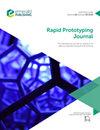A novel eco-friendly abrasive media based abrasive flow machining of 3D printed PLA parts using IGWO and ANN
IF 3.6
4区 工程技术
Q1 ENGINEERING, MECHANICAL
引用次数: 2
Abstract
Purpose Three-dimensional (3D) printed parts usually have poor surface quality due to layer manufacturing’s “stair casing/stair-stepping”. So post-processing is typically needed to enhance its capabilities to be used in closed tolerance applications. This study aims to examine abrasive flow finishing for 3D printed polylactic acid (PLA) parts. Design/methodology/approach A new eco-friendly abrasive flow machining media (EFAFM) was developed, using paper pulp as a base material, waste vegetable oil as a liquid synthesizer and natural additives such as glycine to finish 3D printed parts. Characterization of the media was conducted through thermogravimetric analysis and Fourier transform infrared spectroscopy. PLA crescent prism parts were produced via fused deposition modelling (FDM) and finished using AFM, with experiments designed using central composite design (CCD). The impact of process parameters, including media viscosity, extrusion pressure, layer thickness and finishing time, on percentage improvement in surface roughness (%ΔRa) and material removal rate were analysed. Artificial neural network (ANN) and improved grey wolf optimizer (IGWO) were used for data modelling and optimization, respectively. Findings The abrasive media developed was effective for finishing FDM printed parts using AFM, with SEM images and 3D surface profile showing a significant improvement in surface topography. Optimal solutions were obtained using the ANN-IGWO approach. EFAFM was found to be a promising method for improving finishing quality on FDM 3D printed parts. Research limitations/implications The present study is focused on finishing FDM printed crescent prism parts using AFM. Future research may be done on more complex shapes and could explore the impact of different materials, such as thermoplastics and composites for different applications. Also, implication of other techniques, such as chemical vapour smoothing, mechanical polishing may be explored. Practical implications In the biomedical field, the use of 3D printing has revolutionized the way in which medical devices, implants and prosthetics are designed and manufactured. The biodegradable and biocompatible properties of PLA make it an ideal material for use in biomedical applications, such as the fabrication of surgical guides, dental models and tissue engineering scaffolds. The ability to finish PLA 3D printed parts using AFM can improve their biocompatibility, making them more suitable for use in the human body. The improved surface quality of 3D printed parts can also facilitate their sterilization, which is critical in the biomedical field. Social implications The use of eco-friendly abrasive flow finishing for 3D printed parts can have a positive impact on the environment by reducing waste and promoting sustainable manufacturing practices. Additionally, it can improve the quality and functionality of 3D printed products, leading to better performance and longer lifespans. This can have broader economic and societal benefits. Originality/value This AFM media constituents are paper pulp, waste vegetable oil, silicon carbide as abrasive and the mixture of “Aloe Barbadensis Mill” – “Cyamopsis Tetragonoloba” powder and glycine. This media was then used to finish 3D printed PLA crescent prism parts. The study also used an IGWO to optimize experimental data that had been modelled using an ANN.基于IGWO和ANN的新型环保型磨料流加工3D打印PLA零件
目的:三维(3D)打印件通常由于分层制造的“楼梯套/楼梯步”而导致表面质量差。因此,通常需要后处理来增强其在封闭公差应用中使用的能力。本研究旨在研究3D打印聚乳酸(PLA)零件的磨料流精加工。设计/方法/方法开发了一种新型环保磨料流加工介质(EFAFM),以纸浆为基材,废植物油为液体合成剂,天然添加剂如甘氨酸来完成3D打印部件。通过热重分析和傅里叶变换红外光谱对介质进行了表征。采用熔融沉积建模(FDM)和原子力显微镜(AFM)加工PLA新月形棱镜零件,并采用中心复合设计(CCD)设计实验。分析了工艺参数,包括介质粘度、挤压压力、层厚和整理时间对表面粗糙度改善百分比(%ΔRa)和材料去除率的影响。采用人工神经网络(ANN)和改进的灰狼优化器(IGWO)分别进行数据建模和优化。研究结果:所开发的磨料介质对于使用AFM精加工FDM打印部件是有效的,SEM图像和3D表面轮廓显示表面形貌有显着改善。采用ANN-IGWO方法得到了最优解。EFAFM是一种很有前途的提高FDM 3D打印零件精加工质量的方法。研究的局限性和意义本研究主要针对FDM打印的新月形棱柱零件进行AFM精加工。未来的研究可能会在更复杂的形状上进行,并可以探索不同材料的影响,例如热塑性塑料和复合材料的不同应用。此外,还可以探讨其他技术的含义,如化学蒸汽平滑,机械抛光。在生物医学领域,3D打印的使用彻底改变了医疗设备、植入物和假肢的设计和制造方式。PLA的可生物降解和生物相容性使其成为生物医学应用的理想材料,例如制造外科导板,牙科模型和组织工程支架。使用AFM完成PLA 3D打印部件的能力可以提高它们的生物相容性,使它们更适合在人体中使用。3D打印部件表面质量的提高还可以促进其灭菌,这在生物医学领域至关重要。社会意义3D打印部件使用环保磨料流精加工可以通过减少浪费和促进可持续制造实践对环境产生积极影响。此外,它可以提高3D打印产品的质量和功能,从而获得更好的性能和更长的寿命。这可以带来更广泛的经济和社会效益。本AFM介质成分为纸浆、废植物油、作为磨料的碳化硅以及“芦荟”-“Cyamopsis Tetragonoloba”粉末和甘氨酸的混合物。然后使用该介质完成3D打印PLA新月形棱镜部件。该研究还使用IGWO来优化使用人工神经网络建模的实验数据。
本文章由计算机程序翻译,如有差异,请以英文原文为准。
求助全文
约1分钟内获得全文
求助全文
来源期刊

Rapid Prototyping Journal
工程技术-材料科学:综合
CiteScore
8.30
自引率
10.30%
发文量
137
审稿时长
4.6 months
期刊介绍:
Rapid Prototyping Journal concentrates on development in a manufacturing environment but covers applications in other areas, such as medicine and construction. All papers published in this field are scattered over a wide range of international publications, none of which actually specializes in this particular discipline, this journal is a vital resource for anyone involved in additive manufacturing. It draws together important refereed papers on all aspects of AM from distinguished sources all over the world, to give a truly international perspective on this dynamic and exciting area.
-Benchmarking – certification and qualification in AM-
Mass customisation in AM-
Design for AM-
Materials aspects-
Reviews of processes/applications-
CAD and other software aspects-
Enhancement of existing processes-
Integration with design process-
Management implications-
New AM processes-
Novel applications of AM parts-
AM for tooling-
Medical applications-
Reverse engineering in relation to AM-
Additive & Subtractive hybrid manufacturing-
Industrialisation
 求助内容:
求助内容: 应助结果提醒方式:
应助结果提醒方式:


